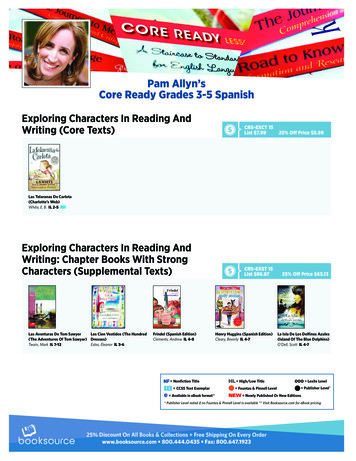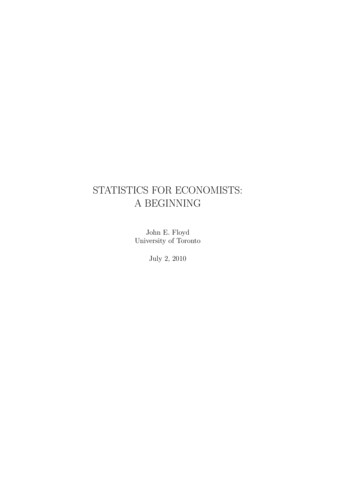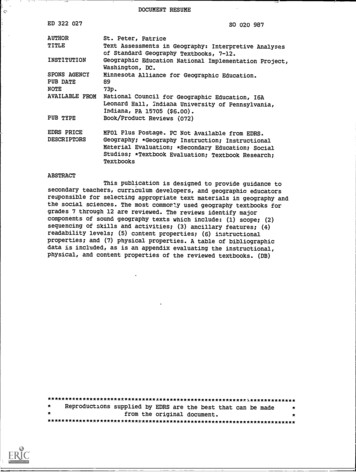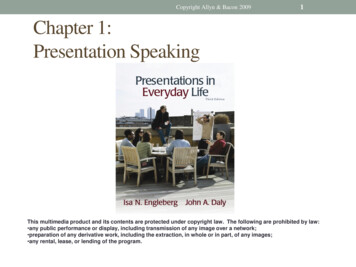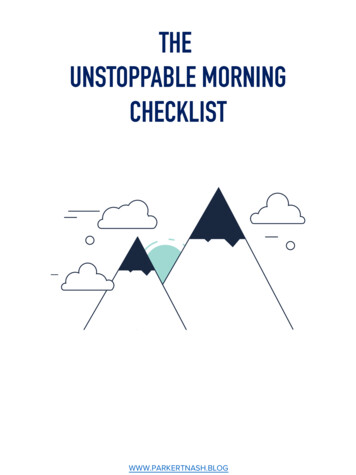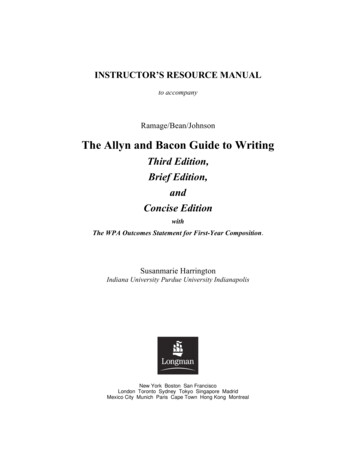
Transcription
INSTRUCTOR’S RESOURCE MANUALto accompanyRamage/Bean/JohnsonThe Allyn and Bacon Guide to WritingThird Edition,Brief Edition,andConcise EditionwithThe WPA Outcomes Statement for First-Year Composition.Susanmarie HarringtonIndiana University Purdue University IndianapolisNew York Boston San FranciscoLondon Toronto Sydney Tokyo Singapore MadridMexico City Munich Paris Cape Town Hong Kong Montreal
NOTE REGARDING WEB SITES AND PASSWORDS:If you need a password to access instructor supplements on a Longmanbook-specific Web site, please use the following or's Resource Manual to accompany Ramage/Bean/Johnson, The Allyn andBacon Guide to Writing, Third Edition, Brief Edition and Concise Edition, with The WPAOutcomes Statements for First-year CompositionCopyright 2003 Pearson Education, Inc.All rights reserved. Printed in the United States of America. Instructors may reproduceportions of this book for classroom use only. All other reproductions are strictlyprohibited without prior permission of the publisher, except in the case of brief quotationsembodied in critical articles and reviews.Credit:“WPA Outcomes Statement for First-Year Composition.” WPA: Writing ProgramAdministration Volume 23.1/2 (Fall/Winter 1999): 59-63, andhttp://www.wpacouncil.org Used by permission.ISBN: 0-321-10892-21 2 3 4 5 6 7 8 9 10—DPC–05 04 03 02
Table of ContentsPrefaceGetting StartedGeneral Teaching StrategiesSuggested Syllabi for The Allyn and Bacon Guide to Writing134Chapter GuidesChapter 1 Posing Problems: The Demands of College Writing39Chapter 2 Pursuing Problems: Exploratory Writing and Talking47Chapter 3 Thinking Rhetorically About Question,Thesis and Support54Chapter 4 Thinking Rhetorically About Purpose,Audience and Genre61Chapter 5 Seeing Rhetorically: The Writer as Observer68Chapter 6 Reading Rhetorically: The Writer as Strong Reader79Chapter 7 Writing an Autobiographical Narrative89Chapter 8 Writing an Exploratory Essay102Chapter 9 Writing an Informative (and Surprising) Essay111Chapter 10 Analyzing Images120Chapter 11 Analyzing Numerical Data128
Chapter 12 Analyzing a Short Story139Chapter 13 Analyzing and Synthesizing Ideas148Chapter 14 Investigating Cause and Consequence156Chapter 15 Writing a Classical Argument165Chapter 16 Making an Evaluation181Chapter 17 Proposing a Solution188Chapter 18 Writing as a Problem-Solving Process196Chapter 19 Composing and Revising Closed-Form Prose204Chapter 20 Composing and Revising Open-Form Prose213Chapter 21 An Introduction to Research212Chapter 22 Finding and Evaluating Sources221Chapter 23 Using, Citing, and Documenting Sources230Chapter 24 Advanced or Specialized Research Skills226Chapter 25 Oral Communication: Working in Groupsand Giving Speeches237Chapter 26 Essay Exams: Writing Well Under Pressure248Chapter 27 Assembling a Portfolio and Writing ReflectiveSelf-Evaluations253Answers to Handbook Exercises257
Specialized InstructionUsing The Allyn and Bacon Guide to Writing withNon-Native Speakers of English263Using The Allyn and Bacon Guide to Writing in anElectronic Classroom277The Allyn and Bacon Guide to Writing and theWPA Outcomes Statement291
PrefaceThe earlier editions of this instructor’s resource manual were enthusiastically receivedby both experienced and novice teachers, who praised the manual’s thoroughness andhelpful advice. In this third edition, the strengths of the earlier editions have been retained,while the contents have been revised and updated in accordance with the changes andimprovements made in the third edition of The Allyn and Bacon Guide to Writing. Mostnotably, discussions are included for all new readings, material has been added to supportthe text’s new emphasis on analyzing visual rhetoric, all chapters are expanded in keepingwith similar revisions in the textbook, and new chapters are included to accompany thetext’s new chapters on analysis and synthesis and oral presentations. In addition, themanual’s chapters on teaching research have been redesigned in light of the extensivechanges in Part 4 of The Allyn and Bacon Guide to Writing. If you are familiar with theearlier edition of this instructor’s resource manual, you will also note that even in placeswhere the textbook remained unchanged, the manual has been revised for improved clarityand direction.The manual begins with “General Teaching Strategies,” a review of practicalsuggestions presented in a question-and-answer format. If you would like even moresupplementary guidance of this nature, contact Allyn and Bacon for a complimentary copyof The Allyn and Bacon Sourcebook for College Writing Teachers by James C. McDonald(a collection of scholarship on composition theory and pedagogy), Teaching CollegeWriting by Maggy Smith (practical tips especially helpful for new writing teachers), AnIntroduction to Teaching Composition in an Electronic Environment by Eric Hoffman andCarol Scheidenhelm, and In Our Own Voice: Graduate Students Teach Writing, by TinaLavonne Good and Leanne B. Warshauer.Other major sections of the manual you may want to read carefully offer advice forplanning a syllabus based on The Allyn and Bacon Guide to Writing and using the textbookwith non-native speakers and/or in an electronic classroom. The manual also containsanswers to the handbook exercises found in the full edition.The last chapter in this manual highlights the ways in which The Allyn and BaconGuide to Writing’s approach offers many opportunities for students to work in each of thefour domains outlined in The Council of Writing Program Administrators OutcomesStatement.The remaining chapters in this manual, numbered to correspond with the chapters inThe Allyn and Bacon Guide to Writing (3rd edition), each contain these sections:“Understanding the Chapter’s Goals”; “Reinforcing the Chapter’s Rhetorical Principles”;
“Using the ‘For Writing and Discussion’ Activities”; and “Guiding Students through theWriting Project.” Chapters 5 through 16, devoted to the writing projects, also include“Discussing the Readings.” You will find the manual most helpful if you at least skim thechapter in the textbook first. Together, the textbook and the manual will give you amplemethods to engage your students in the vital study of writing.AcknowledgmentsI am greatly indebted to my colleagues at Indiana University Purdue UniversityIndianapolis, whose ingenuity and creativity show me new approaches to teaching writingwith every hallway conversation and formal workshop or meeting. I am a better teacher andadministrator because of them. Any errors or infelicities here are of my own creation.I am also grateful to Vicki Byard of Northeastern Illinois University. She wrote thefirst two editions of this resource manual. Her excellent work forms the foundation of thisedition.
General Teaching StrategiesOverviewIn this opening section of the instructor’s manual, you will find many practicalsuggestions to help you accomplish your responsibilities as a writing teacher. If you are ateaching assistant or beginning instructor, you may want to read this section now andreview it again as the course progresses. Even if you are a more experienced teacher, youare still likely to find ideas in this section that can enhance your expertise; scan the headingsfor concerns which especially interest you. The teaching concerns addressed are these: Preparing for the First Day of ClassDesigning Lesson PlansFostering Student ParticipationAsking QuestionsDiscussing ReadingsExplaining In-Class ActivitiesAssigning HomeworkFacilitating Peer Review Workshops on DraftsConferencing with StudentsManaging Journals and PortfoliosGradingKeeping RecordsHandling Difficult Situations and StudentsSeeking Feedback to Improve Your TeachingReading More about Teaching StrategiesBeneath each heading, the teaching strategies are presented in a question-answer formatto help you quickly identify your concerns and find workable solutions.Four additional texts are available from Allyn & Bacon to supplement this discussionof general teaching strategies: The Allyn & Bacon Sourcebook for College Writing Teachersby James C. McDonald, Teaching College Writing by Maggy Smith, and An Introduction toTeaching Composition in an Electronic Environment by Eric Hoffman and CarolScheidenhelm, and In Our Own Voice: Graduate Students Teach Writing by Tina LavonneGood and Leanne B. Warshauer. All of these texts are described in the annotatedbibliography that appears at the end of this chapter. Contact your Allyn & Baconrepresentative if you would like complimentary copies of one or more of these texts. Youmay also wish to access the Allyn & Bacon CompSite Web Page for additional resources at1
2http://www.abacon.com/compsite.Preparing for the First Day of ClassWhat handouts should I prepare for the first class?The most important document is the syllabus. It’s the first formal presentation of thecourse, and it gives students an idea of your goals and teaching style as well as key coursepolicies. On pages 33-37 of this instructor’s manual, there are suggestions for designingsyllabi for quarter-length and semester-length writing courses that use The Allyn and BaconGuide to Writing. In addition to a description of the course goals, overview of majorassignments, grading policies, and a review of any prerequisites, the syllabus should offer adaily or weekly schedule of requirements and activities. Even if you plan to distribute amore detailed schedule as the course moves ahead, use the initial syllabus to show studentsmajor deadlines, approximate reading and writing homework expectations, and examples ofregular in-class activities. The syllabus should also provide contact information: when andwhere students can reach you (your office location and hours, your office phone number,fax number if you use it, and your e-mail address). The syllabus should also communicateyour expectations for students’ behavior (what kinds of participation you expect, whatpenalties may be imposed for absence or late work, for example), as well as what studentsmay expect from you (how quickly do you respond to essays, for example). If you havefirm preferences for the format of assignments, outline those on the syllabus, even if theywill be repeated on individual assignment sheets. Tell students up front whether youaccept handwritten essays, require that planning work be turned in with the final version,prefer particular margin settings, or have opinions about the uses of staples, paper clips, orfolders.Another document many teachers like to distribute on the first day is a questionnairethat asks students information about themselves. You may want to know how you cancontact them if necessary outside class time (address, home and work phone numbers, email address), their year in school, their academic advisor, their major(s) and possibleminor(s), their prior writing experience, other responsibilities at home or work that maylimit the time they can devote to your course, and any special concerns they may haveabout this course. While some teachers ask students to write basic contact information onindex cards or ask students to answer these questions on their own paper, others prefer aquestionnaire so that students can complete the form at home and return it when the classnext meets. Any students who miss the first day of class can simply be handed thequestionnaire to complete, along with the syllabus and other course handouts they mayhave missed. A questionnaire also allows for a few open-ended questions that can acquaint
3you with students more quickly and can be used as a disguised (and therefore less anxietyprovoking) diagnostic of students’ writing abilities. Some possible opening-day questionsinclude:
4 What are your tentative educational and career goals?What previous writing courses have you had? What types of papers didyou write in these courses?Do you usually like or dislike writing? Why?What kinds of reading and writing do you do outside of school?What is your opinion of your writing ability? What are your strengths?Your weaknesses?What do you hope to accomplish in this writing course? Are there anyparticular aspects of your writing ability you want more help with?What should I try to accomplish during the first few class sessions?Certainly it’s important that students learn the goals of the course and what work willbe required of them. Using the first class period to begin working on the first writingassignment communicates to students that class time matters and will be used to helpassignments move forward. Design a first-day, in-class writing assignment that functions asa lead-in to the first assignment. Collecting writing quickly from your students will allowyou to begin a routine of reading and responding to student work, and it will allow you toget a feel for the writing styles in your class.The first few class sessions are also vitally important for establishing the learningenvironment you want to create and building rapport with your students. Try to learn yourstudents’ names as quickly as possible, asking them to correct your mispronunciations andto tell you if they prefer to be called by other names or shortened nicknames. It may helpyou to ask students to identify themselves before they speak in class for the first fewsessions. Call students by name as often as possible so that students can learn each other’snames as well.Some teachers like to use an icebreaker during the first or second class to help studentsbecome acquainted. An icebreaker makes students more comfortable with the teacher andtheir classmates, which can make participating in subsequent class discussions and smallgroup activities less intimidating. Because students may be self-conscious introducingthemselves, a common icebreaker is for students to interview each other in pairs and theneach introduce his or her partner to the class.Another icebreaker that works well is to give students a list of tasks and ask them tocirculate among the room until they have completed every task. The tasks are structured topromote information conversation and get students learning each others’ names quickly.You can ask students, for example, to find someone who spends twice as much time as theydo driving to campus, someone who has more siblings than they do, someone who has never
5read their own favorite book, someone who went to a similar-sized high school, etc. Thisicebreaker gets students moving around the room, starting conversations that identifysimilarities and differences in the group.You may also want to address during the first few class sessions your students’attitudes about writing or school that could affect their work in your course. In smallgroups or as a class, ask students to discuss how their current attitudes toward writingdeveloped. What did they like and dislike about their past writing courses, their pastwriting instructors, and their past writing assignments? Explaining ways this course islikely to be different from their past writing courses--such as the opportunity to write openform texts (explained in Chapter 1 of The Allyn and Bacon Guide to Writing)--may increasetheir enthusiasm for the course. It is helpful for students to be aware of any attitudes theymay have that may affect the way they approach working in college, and it is also helpfulfor students to set personal goals for the semester.During the first few class sessions, try to use the full range of pedagogical formats youintend to use throughout the term (for example, lecture, class discussion with the chairsarranged traditionally, class discussion with the chairs arranged in a large circle, and smallgroup work). When students are introduced to various seating arrangements and activitiesquite early in the term, they have more time to get used to the demands of each format.Designing Lesson PlansWhy are lesson plans important?While the syllabus provides the goals and schedule for the entire term, a lesson planindicates the goals and agenda for one class session. To understand why both macroscopicand microscopic plans are important, consider the similarity between designing a writingcourse and designing a handmade quilt. For both, the maker needs to be concerned with thepattern of each smaller unit (each class meeting; each quilt square) as well as how thesmaller units are artistically combined to contribute to the larger product (the course orquilt). Obviously, such complex planning is difficult to complete in one’s head. Writinglesson plans helps you to prepare for each class more thoroughly. Planning for each sessionin writing also prompts you to reflect on how to connect one class to the next.The lesson plan has two audiences: you and your students. For teachers, lesson plansprovide an organization and a structure. For students, lesson plans help them recognize thestructure within each unit. Once you set goals for each class period with the lesson plan,communicate them with students. This helps students learn more effectively.
6What should a good lesson plan include?Begin designing your lesson plan by deciding on the objectives for the class session(based on the syllabus), the chapter of The Allyn and Bacon Guide to Writing students arecurrently reading, and their upcoming writing project. Once you’ve articulated the goal forthe day--and one main goal is plenty--decide how that objective can practically be achieved.Think of the class session as several fifteen- or twenty-minute segments. Strive tocover just one main concept per time segment, using a variety of examples and in-classactivities to illustrate the concept. According to composition scholar George Hillocks, whosystematically compiled the results of over sixty research studies of different pedagogicalapproaches to writing courses, students best learn writing through hands-on, inductiveactivities that allow them to grapple with the underlying principles at stake. The in-classactivity may be done individually, in pairs or small groups, or as a full class. Afterwards,the teacher facilitates a discussion of the concepts learned through the activity. Optimally,each class period will introduce a new skill or activity, allow students the chance to practicethat activity with others, and will then ask students to work on their own.Thus, when you are developing lesson plans, try to think of activities that canintroduce students experientially to the concepts you wish them to understand. There aremany ideas for such activities in The Allyn and Bacon Guide to Writing textbook and thismanual, but add your own as well. Rather than creating a lesson plan that focuses on thequestion “What will I be doing during class?,” try planning the class by asking, “What willthe students be doing during class?” and “What will students be able to do after class thatthey couldn’t do before?” This will help you create lesson plans that keep each assignmentmoving according to your schedule.In addition to in-class activities, it is helpful to plan in advance some provocativequestions for class discussion (see “Asking Questions” on page 9).You may want to begin each class session by quickly outlining for students in a cornerof the chalkboard the agenda for that day’s class session. Both you and students can thenkeep the day’s goals in mind and be less tempted to drift from the topic. Previewing theplans with students also helps them to better understand the relationships among that day’sdiscussion topics. End every class by asking student volunteers to summarize theprinciples they learned during the period and the relationship of these principles tostudents’ next writing project. Also announce any homework, remind students what, ifanything, they need to hand in that day, and forecast the topic of the next class meeting.How do I decide how much to cover in each class session?
7The mistake that many beginning teachers make is trying to cover too much in a classsession. As you gain experience as a teacher, you will be better able to judge how muchmaterial to cover. You will also learn that, even for the same course at the same college,each group of students learns at a different rate. Thus, you will need to make adjustmentsas you get to know each class each term.As a guideline for starting out, limit your lesson plan to just two or three concepts foreach class session; then decide what activities you will use to teach these. Reserve time todiscuss the activities afterwards. Until you become comfortable with managing class time,also plan a brief discussion topic or activity that can be done if students finish what you’veplanned much more quickly than you expected. If this additional idea isn’t needed, youmay use it at the beginning of the next class session or save it for another day when thediscussion ends prematurely. If you always have a standby discussion topic or activityready, you’ll have no need to panic and dismiss students early, a detrimental precedent thatcan make students less attentive at the end of subsequent class sessions.Fostering Student ParticipationWhy is student participation important?Participation helps students learn better: they get to try out their ideas and, based onthe response they receive from you and classmates, probe their own understandings further.Through student participation, the classroom becomes less teacher-centered. Students canlearn much from each other; encourage students to directly address and respond to eachother in full-class discussions, rather than using you as an intermediary.How can I encourage more student participation?The most important thing you can do to encourage student participation is to showstudents that participation matters. If you organize class activities so that students whoparticipate in them move forward on whatever writing project is underway, students willvalue their participation. If participation comes to mean joining in a conversation about anessay in the book that is not clearly connected to the next writing assignment, or joining aconversation about current events without a related writing project underway, students willnot see participating in class as valuable. Strive to construct activities that get studentsworking with their drafts, developing new material or evaluating old material. If theactivities you plan make a difference in the evolution of formal writing projects, studentswill respond well.
8A good principle for encouraging participation: have homework before every classperiod that requires students to prepare something, even if it is an answer to a simplequestion, a short informal writing assignment, or some additions to a current draft. Havediscussion and activities that enable students to work with others during the class period tobuild on that preparation, and then assign homework that allows students to practice alonewhat they did with others in class. This cycle will ensure that each class period followswell on the next, and it will get students into a consistent habit of participation andpreparation.Sometimes students don’t participate in discussions because they don’t feel they arean integral part of the class. If you frequently lecture for long periods, they may think theirinvolvement is unimportant and remain passive even when you ask them for their input.Try to routinely structure class so that students have an opportunity to speak within thefirst ten minutes of the period. Students will then be likely to contribute to discussionsmore often and at more length.The majority of the class may also be quiet if they feel that a few vocal students arewilling and able to carry the class discussion. Acknowledge frequent contributors but don’tlet any one student monopolize the discussion (e.g., “Thanks, David. I see your hand, butis there someone who hasn’t spoken today who’d like to answer?”). You may have astudent who regularly blurts out answers to your questions, while others wait to be calledupon. Often a student who speaks out of turn sits in the front of the room and does notrealize that students sitting further back want to participate. Simply ask this eager studentto raise his or her hand so that you can include everyone in the discussion.To encourage your students to participate more equally, direct questions to studentssitting in different areas of the room. Make sure your eye contact is with all students, butparticularly those in an area of the room where few people talk. If you tend to stand or sitin the front of the classroom, move from side to side rather than regularly positioningyourself in front of the same students. If you walk around in the front of the room, walktowards the desks of the students who are most quiet or inattentive; often your physicalpresence alone will be enough to regain their attention and invite them to speak.Sometimes students need a “warm-up” to discussion. If you want the class to discussmaterial they read for homework, first ask someone to summarize that reading, to remindthe class of its contents. Then ask remaining students to add any other details theyremember as important that weren’t yet mentioned. After focusing their minds on thereading in this manner, students will be better equipped to answer more challengingquestions. If students are non-responsive when you ask a difficult, abstract question, givethem a few minutes to first explore an answer in writing themselves or discuss theirimpressions with a classmate, and then ask several students to share their ideas with the
9class.The examples you use to illustrate writing concepts also affect students’ participation.Your examples should reflect the diversity of your students’ backgrounds. For example, ifsome of your students are older than recent high school graduates, using activities ordiscussion topics that imply dependency on a parent will make these students feel they arenot equal members of the class. Be alert to other possible biases in your examples too:gender; race; ethnicity; socioeconomic class; ablebodiedness; religion; etc. Use genderneutral terms such as “significant other” or “partner” if you refer to romantic relationshipsto avoid assuming all students are heterosexual. If you show awareness of students’differences and accommodate the breadth of their identities in class discussion, studentswho might feel they are a minority within the class will feel more comfortable participating.Students are also more likely to talk in class when they feel comfortable with the otherstudents. You may want to hold discussions with the class sitting in a large circle so theycan see one another. If so, vary the location of your own seat each time so that you becomea more integral part of the circle and no one spot becomes viewed as the position ofauthority. Small group activities can also help students become acquainted and feel morecomfortable sharing their thoughts.When students do talk, listen. Nothing else you can do is more powerful in solicitingfurther student participation. Ask follow-up questions respectfully and encouragingly.Whenever possible, validate students’ participation by using the students’ exact wording inyour response and when you write their ideas on the chalkboard.When a student gives a wrong answer, how you respond will affect not only thatstudent’s future participation in class but also the participation of every student whoconsiders it intimidating to talk in class. Never embarrass a student. First try to find thesource of the person’s misunderstanding by asking “Why do you think that?” (ask this ofstudents who give correct answers too) and if possible then ask questions about theirexplanation that will eventually lead them to the correct answer. Instead of stepping in asthe “answer-giver,” give that role to the class by asking, “Does anyone disagree? Why?”Even if the first person to disagree gives the correct answer, if you think other students willhave different responses, ask for their views too and lead the class to explore all theresponses that are given.Is it fair to require all students to talk in class?Deciding whether or not to require all students to participate in class is difficultbecause the decision must be based on two quite significant yet disparate issues: what roleyou believe participation plays in the learning process, and how committed you are torespecting students’ personal (and even cultural) differences.
10A colleague tells a story about encountering a former student whom she had during hisfirst semester of college. Then on the point of graduation, the student told my colleaguehow much he had enjoyed her course, even though he thought she hadn’t realized thatbecause he had never spoken in class. “In fact,” he said, with obvious regret, “I’ve neverspoken in any college class I’ve taken.” He was a second-language student who feared otherstudents might not understand his accent; the motives may differ for other silent students.This conversation illustrates that if teachers can do more to nurture into classroomdiscourse those students who almost never speak, particularly in first-year courses, theirentire educational experience may change.If you notice students who haven’t spoken after the first several weeks of class, youmay want to call on them at particularly non-threatening times (to answer a simple questionor to read a brief passage from the textbook aloud). Another strategy to help excessivelyquiet students feel comfortable speaking is to gently tell them after class that you’venoticed they haven’t participated and then identify a specific question or topic you’ll askthem about during the following class period so that they will have a chance to prepare.With a few such empathetic nudges, silent students may begin to participate more regularly.If any portion of the course grade is determined by students’ participation, clearlyidentify for students how you will evaluate this and at several points during the term tel
Chapter 1 Posing Problems: The Demands of College Writing 39 . Indianapolis, whose ingenuity and creativity show me new approaches to teaching writing with every hallway conversation and formal workshop or meeting. I am a better teacher and administrator because of them

